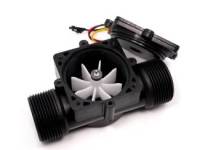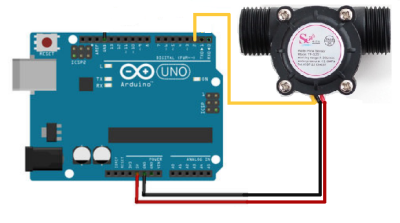Áramlásmérés
YF-S201
Az YF-S201 az egyik leggyakrabban alkalmazott, Hall-effektuson alapuló szárnykerekes áramlásmérő.
Az Arduino áramlásmérő a Hall Effect elvén működik. Ennek megfelelően a villamos árammal merőleges mágneses mező elmozdulása esetén feszültséget indukál. A folyadék a forgórész bordáihoz ütközik, és ezt elforgatja. A rotor tengelye fölött egy Hall érzékelő található, mely a rotor tengelyére rögzített mágnes elmozdulását figyeli, így minden megtett elfordulás egy impulzust hoz létre. Az áramlásmérőben átalában literenkénti és percenkénti átáramló folyadékmennyiségnél körülbelül 4,5 impulzus érkezik (nyilván ez az érzékelő méretezésétől függ).
A szenzor bekötése
A meglehtősen rövid impulzusok számlálásához az Arduino megszakítás-portját érdemes használni.
Ennek leírása itt található: interrupt port.
Az interrupt híváshoz szükséges funkciók leírása itt található:
Példaprogram
/* Liquid flow rate sensor -DIYhacking.com Arvind Sanjeev Measure the liquid/water flow rate using this code. Connect Vcc and Gnd of sensor to arduino, and the signal line to arduino digital pin 2. */ byte statusLed = 13; byte sensorInterrupt = 0; // 0 = digital pin 2 byte sensorPin = 2; // The hall-effect flow sensor outputs approximately 4.5 pulses per second per // litre/minute of flow. float calibrationFactor = 4.5; volatile byte pulseCount; float flowRate; unsigned int flowMilliLitres; unsigned long totalMilliLitres; unsigned long oldTime; void setup() { // Initialize a serial connection for reporting values to the host Serial.begin(9600); // Set up the status LED line as an output pinMode(statusLed, OUTPUT); digitalWrite(statusLed, HIGH); // We have an active-low LED attached pinMode(sensorPin, INPUT); digitalWrite(sensorPin, HIGH); pulseCount = 0; flowRate = 0.0; flowMilliLitres = 0; totalMilliLitres = 0; oldTime = 0; // The Hall-effect sensor is connected to pin 2 which uses interrupt 0. // Configured to trigger on a FALLING state change (transition from HIGH // state to LOW state) attachInterrupt(sensorInterrupt, pulseCounter, FALLING); } /** * Main program loop */ void loop() { if((millis() - oldTime) > 1000) // Only process counters once per second { // Disable the interrupt while calculating flow rate and sending the value to // the host detachInterrupt(sensorInterrupt); // Because this loop may not complete in exactly 1 second intervals we calculate // the number of milliseconds that have passed since the last execution and use // that to scale the output. We also apply the calibrationFactor to scale the output // based on the number of pulses per second per units of measure (litres/minute in // this case) coming from the sensor. flowRate = ((1000.0 / (millis() - oldTime)) * pulseCount) / calibrationFactor; // Note the time this processing pass was executed. Note that because we've // disabled interrupts the millis() function won't actually be incrementing right // at this point, but it will still return the value it was set to just before // interrupts went away. oldTime = millis(); // Divide the flow rate in litres/minute by 60 to determine how many litres have // passed through the sensor in this 1 second interval, then multiply by 1000 to // convert to millilitres. flowMilliLitres = (flowRate / 60) * 1000; // Add the millilitres passed in this second to the cumulative total totalMilliLitres += flowMilliLitres; unsigned int frac; // Print the flow rate for this second in litres / minute Serial.print("Flow rate: "); Serial.print(int(flowRate)); // Print the integer part of the variable Serial.print("L/min"); Serial.print("\t"); // Print tab space // Print the cumulative total of litres flowed since starting Serial.print("Output Liquid Quantity: "); Serial.print(totalMilliLitres); Serial.println("mL"); Serial.print("\t"); // Print tab space Serial.print(totalMilliLitres/1000); Serial.print("L"); // Reset the pulse counter so we can start incrementing again pulseCount = 0; // Enable the interrupt again now that we've finished sending output attachInterrupt(sensorInterrupt, pulseCounter, FALLING); } } /* Insterrupt Service Routine */ void pulseCounter() { // Increment the pulse counter pulseCount++; }



